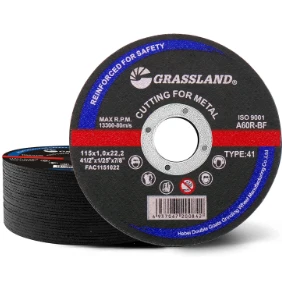The Essential Guide to Metal Cutting Discs for Grinders
Metal cutting discs are vital tools in the world of fabrication, construction, and metalworking. With the swift advancement of technology and the growing demand for precision, these discs have evolved significantly over time. This article will delve into the various types of metal cutting discs available for grinders, their specifications, and tips for optimal use.
Types of Metal Cutting Discs
1. Abrasive Discs These are the most common types of cutting discs. Made from a composite of abrasive particles, such as aluminum oxide or silicon carbide, abrasive discs are ideal for cutting metals like steel and iron. Their affordability and efficiency make them a popular choice among both professionals and DIY enthusiasts.
2. Diamond Blades For those who require precision cutting, diamond blades are an excellent option. These discs feature diamond particles embedded into the cutting surface and are designed for cutting harder materials, including stainless steel and cast iron. Although they tend to be more expensive, their durability and ability to maintain a sharp edge over time provide excellent value.
3. Thin Metal Cutting Discs These discs are engineered for speed and precision. Their thinner profile allows for faster cuts with less material wastage and heat generation. They are particularly beneficial for projects that require detailed work or where the aesthetic finish is paramount.
4. Thick Metal Cutting Discs Thicker discs are intended for heavy-duty cutting tasks. They offer enhanced stability and durability, allowing them to cut through larger sections of metal. These discs are often preferred in industrial settings where heavy machinery and robust materials are common.
Specifications to Consider
When selecting metal cutting discs for grinders, several specifications should be considered
- Diameter Metal cutting discs come in various diameters, typically ranging from 115mm to 400mm. The diameter size must be compatible with the grinder you are using.
- Thickness Thinner discs allow for quicker cuts but may wear out faster, while thicker discs provide greater durability. Choose based on the type of cutting you expect to do.
metal cutting discs for grinder

- Material Type Ensure the disc is suitable for the specific type of metal you are working with
. Some discs perform better on ferrous metals, while others are designed for non-ferrous materials.- RPM Rating Always check the recommended RPM (revolutions per minute) rating for the disc. Operating a disc above its rated RPM can be dangerous and lead to failure.
Safety Measures
Using metal cutting discs entails certain risks, so proper safety measures are crucial. Always wear appropriate personal protective equipment (PPE), including goggles, gloves, and ear protection. Additionally, make sure your work area is clear, and that the grinder is in good condition before use.
Tips for Optimal Use
To ensure you get the best performance from your cutting discs, consider the following tips
- Maintain a steady feed rate Applying too much pressure can cause the disc to wear out quickly or even break. Allow the tool to do the work.
- Keep the disc cool If you notice excessive heat buildup, take breaks to allow the disc to cool down to prevent damage.
- Inspect regularly Check your discs for signs of wear, damage, or cracking. Replacing worn discs promptly is necessary for both safety and efficiency.
In conclusion, metal cutting discs are indispensable tools for anyone involved in metalworking. Understanding the different types of discs, their specifications, and following safety practices ensures you can achieve precise and efficient results in your projects. Whether you are a professional tradesperson or a passionate DIYer, investing in quality cutting discs will elevate the standard of your work and contribute to your overall success.
Post time:Dec - 01 - 2024

















